The Mark Levinson (The Man) Experience
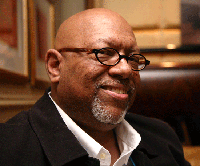 I’m starting off this year’s report by telling you about the most memorable experience I had during the week because it actually sets the stage for what I thought about a lot of what I saw at this year’s Consumer Electronic Show (CES) and The Home Entertainment Show (T.H.E. Show).
I’m starting off this year’s report by telling you about the most memorable experience I had during the week because it actually sets the stage for what I thought about a lot of what I saw at this year’s Consumer Electronic Show (CES) and The Home Entertainment Show (T.H.E. Show).
I was walking the halls of the Venetian Hotel, where most of the high-end audio exhibits were, with Doug White, the owner of The Voice That Is, a high-end shop located in Newtown Square, PA. When Doug and I were urged to go to the 34th floor to hear a demonstration being given by none other than audio icon Mark Levinson (left). Levinson is a consultant for a company called Intersil D2Audio (a division of Intersil Corporation).
The demonstration was of an integrated circuit technology developed by Levinson called the “MightyCat.” The MightyCat IC technology was designed for the audio component manufacturing industry as a way to maximize the performance of audio components, bringing less expensive components to a higher level of performance and bring audiophile quality music reproduction to the vast majority of music lovers and not only the well heeled.
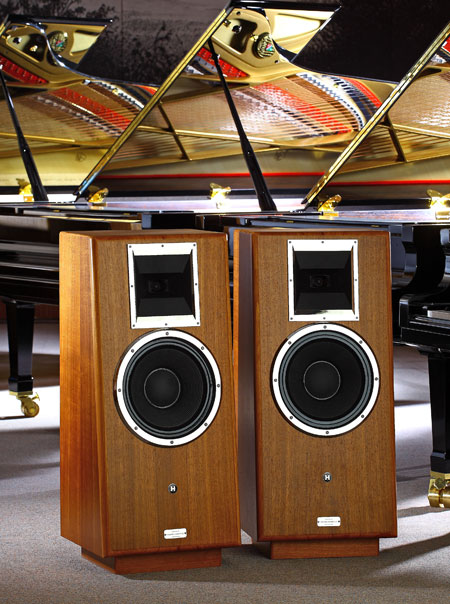 So how did the demo go you ask? Well, perched atop a pair of Levinson’s own $25,000 Daniel Hertz M7 loudspeakers (Daniel Hertz is Levinson’s new Neuchâtel, Switzerland based audio company) was a pair of tiny Logitech computer speakers. Now let’s not be silly, this was not a demonstration of how close the little Logitechs could get to the sound of the M7s. In fact, the M7s weren’t even played during the demo when I was there. Instead, Levinson began playing music through the Logitechs in their basic form and they sounded like… crappy little computer speakers. No surprise there. But then he played the same music on the same speakers but now with the MightyCat IC installed. The result..? It’s been a week since hearing this demo, and frankly, I am still struggling to explain what I heard. My initial reaction was of stunned disbelief. I just sat in my chair and chuckled. It was as if the little Logitechs had been “…belted by gamma rays” and turned into the Incredible Hulk. Suddenly, these speakers had a little soundstage with front-to-back depth and space, and there was even a surprising amount of image specificity. But most incredibly, there was bass! Not deep bass, mind you, but certainly more bass than I would have thought possible. Simply put the MightyCat technology made the unlistenable, listenable. The demo was brief but long enough for me to begin wondering what type of effect this technology might have on my system and in fact, the audio industry as a whole. Either way, Levinson could be on the verge of shifting the dynamics of the audio industry once again, accept this time he’s inviting everyone to the party, regardless of socio-economic stature. Don’t get me wrong, I’m not saying that Levinson is shifting towards becoming a maven of mid-fi stereo systems. In fact, if you were one of the few people who were lucky enough to hear the full Daniel Hertz system, anchored by the gloriously expensive M1 loudspeaker ($100,000) over at the Bellagio, you know that he is still very much committed to the highest of the high-end. But with the MightyCat technology, he could be seriously upping the ante of what’s possible for relatively little money.
So how did the demo go you ask? Well, perched atop a pair of Levinson’s own $25,000 Daniel Hertz M7 loudspeakers (Daniel Hertz is Levinson’s new Neuchâtel, Switzerland based audio company) was a pair of tiny Logitech computer speakers. Now let’s not be silly, this was not a demonstration of how close the little Logitechs could get to the sound of the M7s. In fact, the M7s weren’t even played during the demo when I was there. Instead, Levinson began playing music through the Logitechs in their basic form and they sounded like… crappy little computer speakers. No surprise there. But then he played the same music on the same speakers but now with the MightyCat IC installed. The result..? It’s been a week since hearing this demo, and frankly, I am still struggling to explain what I heard. My initial reaction was of stunned disbelief. I just sat in my chair and chuckled. It was as if the little Logitechs had been “…belted by gamma rays” and turned into the Incredible Hulk. Suddenly, these speakers had a little soundstage with front-to-back depth and space, and there was even a surprising amount of image specificity. But most incredibly, there was bass! Not deep bass, mind you, but certainly more bass than I would have thought possible. Simply put the MightyCat technology made the unlistenable, listenable. The demo was brief but long enough for me to begin wondering what type of effect this technology might have on my system and in fact, the audio industry as a whole. Either way, Levinson could be on the verge of shifting the dynamics of the audio industry once again, accept this time he’s inviting everyone to the party, regardless of socio-economic stature. Don’t get me wrong, I’m not saying that Levinson is shifting towards becoming a maven of mid-fi stereo systems. In fact, if you were one of the few people who were lucky enough to hear the full Daniel Hertz system, anchored by the gloriously expensive M1 loudspeaker ($100,000) over at the Bellagio, you know that he is still very much committed to the highest of the high-end. But with the MightyCat technology, he could be seriously upping the ante of what’s possible for relatively little money.
Another endeavor that Levinson told Doug and I about was a fundraising effort to preserve a historical Venetian opera house called La Fenice. Levinson and opera singer Jose Andrade have produced a 28 CD boxed set and 170 page color art book called the Legend of La Fenice, which is about the opera house and the music created there. The cost of the CDs and booklet is a donation of 1,000 Euros (approx. $1,200 USD) to La Fenice. May be well worth looking into if you’re a fan of classical music and opera.
The MightyCat/Intersil D2Audio demo was not the end of my encounter with Levinson. The following morning, my girlfriend Mittie and I were near the front of the cab line at the MGM Grand, waiting for a taxi when a rather hurried Levinson walked up and asked if we were going to the Venetian. He said that he was running late for a meeting and offered to pay for the cab ride if we allowed him to ride with us. I couldn’t say “yes” fast enough, and soon we were in the cab and on our way. I re-introduced myself and told him that I had heard his MightyCat demo the day before and what an incredible product I thought it was. During the fifteen minutes we spent in that cab, he told me a lot about the audio industry, and in particular, some of his own personal and professional ups and downs and some of the darker aspects of the business. This conversation continued later that same evening when I ran into Levinson once again in the lobby of the MGM Grand while waiting to meet up with Arnold Martinez from Tweak Studio in Chicago.
A lot of what Mark and I discussed was of a personal nature so I won’t go into any of it here. But the main thing we discussed was the current state of high-end audio and the lack of honesty in what passes these days for audio equipment. He urged me to “be truthful” in my reporting. So in my remaining show reports, I will.
T.H.E. Show
My week began at the T.H.E. Show in the Flamingo hotel. As you might expect things started out pretty slowly over there as most show attendees tend to start things at the Venetian where the CES exhibits are. Still, I’ve always found the people who work behind the scenes at the T.H.E. Show to be super-pleasant and helpful, a far cry from the madness going on at the Venetian.
After getting checked in and picking up my “PRESS” credentials (more importantly my lunch ticket), I headed straight for the T.H.E. Marketplace which featured vendors selling vinyl, CDs, software and all manner of tweaks. Here is where I found companies such as Amarra, Sonic Studio, Bob’s Devices, Ultra Systems, Reference Recordings, Elusive Disc, Woo Audio and M.A. Recordings. This is also where I found Arnold Martinez, also a Chicago resident who is also the sole proprietor of Tweak Studio, a high-end dealership that showcases products from Burmester, Genesis Advanced Technologies, SOTA and others. Oddly enough, Arnold didn’t have any products on display, just the signage for his store and some Burmester brochures. This was unfortunate because Arnold is one of the nicest guys you can hope to meet in this industry and is a wealth of knowledge on room and especially turntable setup. He would have done well to have brought in one of his SOTAs and conducted turntable setup clinics.
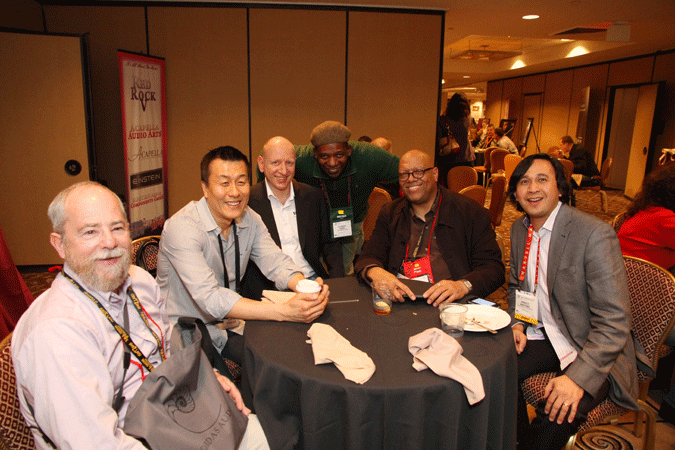
After saying hello to Arnold (above right), I hooked up with fellow Stereo Timers Don Shaulis (left), Key Kim (second from Left), the Stein Harmonizer magician Holger Stein (to my right) and our publisher Clement Perry (standing). Running into Clement at a show is always a blessing and a curse. A blessing in that you won’t find a more enjoyable person to be around. He knows everybody and I do mean everybody!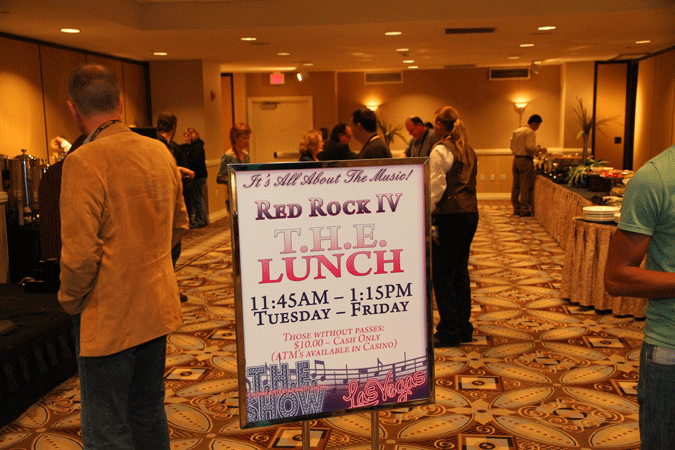 From the show staffers to some of the biggest names in the audiophile industry (if there is such a thing), everyone stops to get a handshake or a friendly hug from Clement Perry. The curse in all this is that he also tends to make time fly by. I could have sworn I was just starting my day and the next thing I knew it was already after noon and Clement was saying “…we’d better grab some lunch before all the food is gone.” Luckily the folks at the T.H.E. Show know how to put out a spread. There was plenty of great food but not a lot of time. So I scarfed down lunch and headed off to the rooms.
From the show staffers to some of the biggest names in the audiophile industry (if there is such a thing), everyone stops to get a handshake or a friendly hug from Clement Perry. The curse in all this is that he also tends to make time fly by. I could have sworn I was just starting my day and the next thing I knew it was already after noon and Clement was saying “…we’d better grab some lunch before all the food is gone.” Luckily the folks at the T.H.E. Show know how to put out a spread. There was plenty of great food but not a lot of time. So I scarfed down lunch and headed off to the rooms.
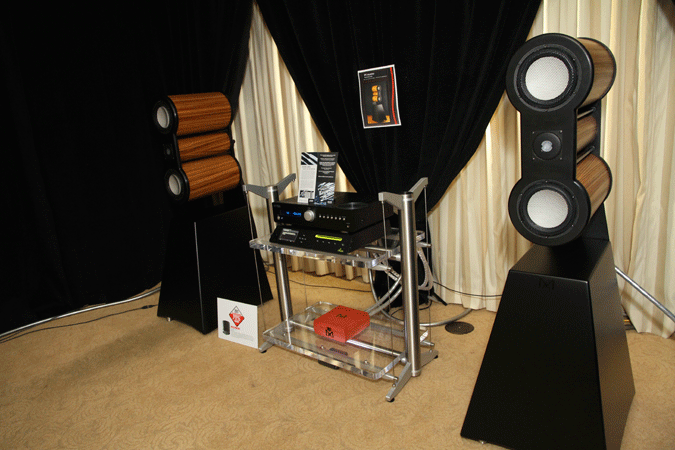
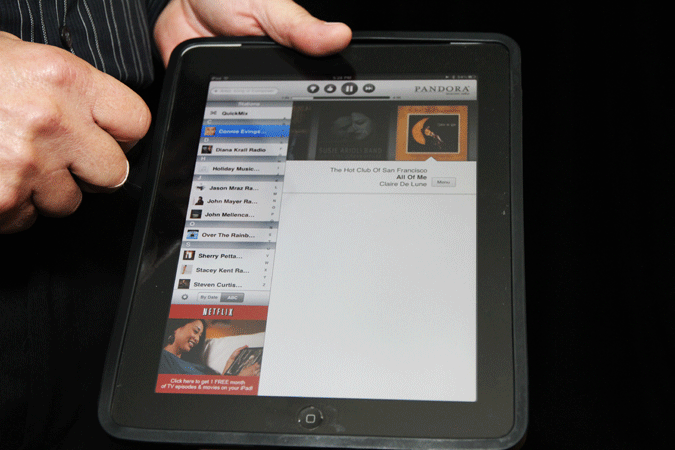
One of the first rooms that I visited was the M Audio room where they were demonstrating their new Model 10 loudspeakers ($35,000/pair). M Audio is a new company from Tom Maker, formerly of Edge Electronics. The Model 10 uses a pair of ceramic midrange drivers and a diamond tweeter in a D’Appolito configuration on top and a 12” woofer on the bottom. The speakers are powered by 1100 watts/channel of amplification and also feature a DSP processor so that allows you to run a digital source wirelessly. This room also featured products from ZenSati cable and Stillpoints audio racks and isolation devices. The Model 10s are very attractive speakers and sounded fairly nice, but the room setup was loaded with drapery and I think may have been over dampened a bit. I still think it’s an exciting speaker and can’t wait to hear it under better conditions.
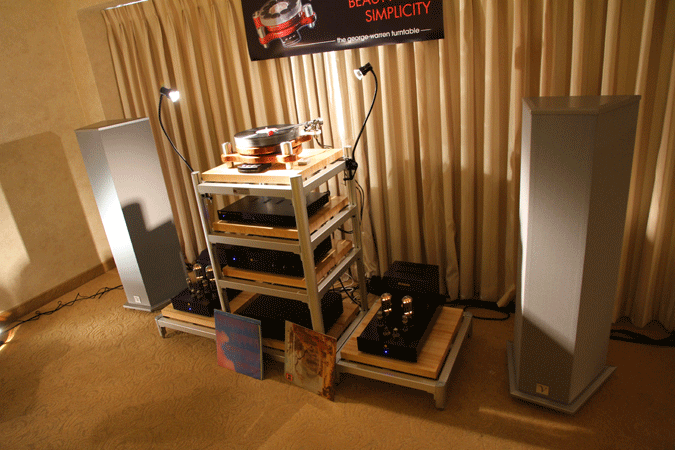
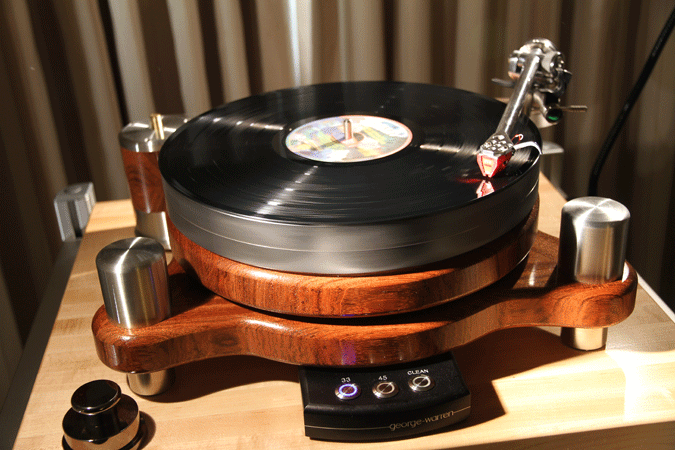
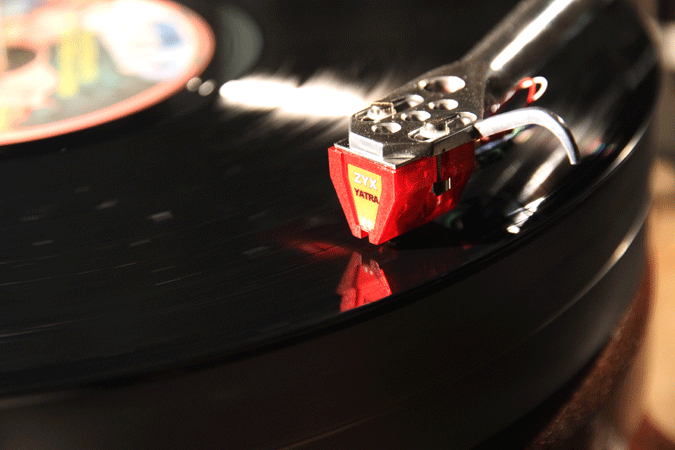
As I started to head down the hall to see more rooms, I noticed a woman with a big smile on her face and Clement standing next to her pointing at me. Suddenly she says, “There’s Dave Thomas.” So I looked at the sign on the door and realized she was the wife of George Widman, the designer of the Stereo Times Most Wanted Component award winning George Warren Precision Sound turntable ($3,995). When I walked in George was in the middle of demonstrating his table so I took a moment to admire his handiwork. I reviewed and am using a black acrylic version of his table in my system currently, so this was the first time that I was able to see and hear the gorgeous walnut version ($4,495). The table was outfitted with a Moth 1000 Incognito wired tonearm ($1,495) from Brittaudio and ZYX Yatra cartridge. George’s fine sounding demo system included Jolida tube electronics and a pair of Von Schweikert VR-35 Export Deluxe loudspeakers ($7,995/pair). The popularity of this table must be catching on because soon after the show got started, another company came by and asked to borrow one of George’s spare tables to replace the table they were using in their demo.
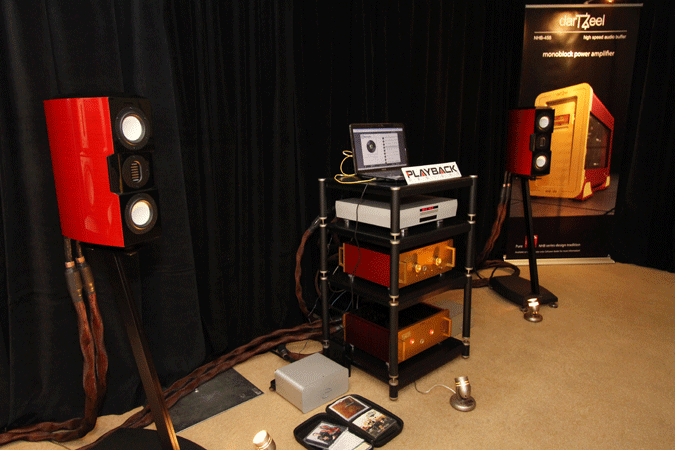
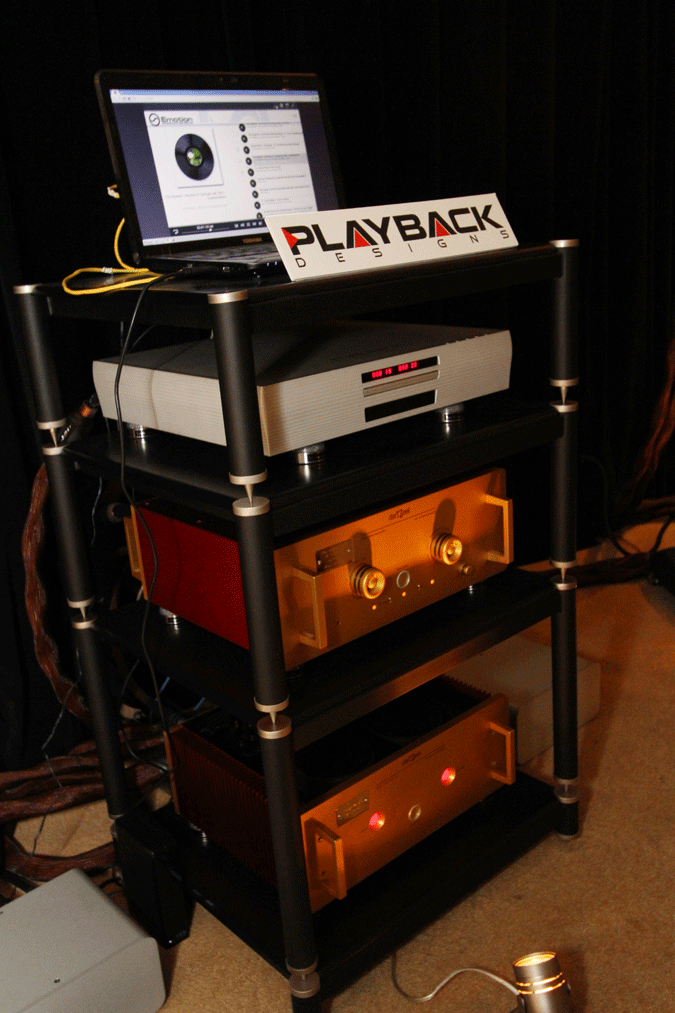
Evolution Acoustics blew me away with their MMMicro One loudspeakers. This is another speaker using the D’Appolito configuration with two 4” ceramic drivers and a 2” Pleated Diaphragm Air Velocity tweeter. It’s a gorgeous looking and sounding little speaker and retails for only $2,500/pair including their own stands. This may prove to be one of the best bargains in audio. The sound of this room did benefit greatly from excellent electronics from darTZeel (NHB-18 NS preamp and NHB-108 Model B amp) and the excellent Playback Designs MPS-3 CD player. Still, $2,500 for a speaker I thought would have cost many times the price, makes it well worth seeking out. I hope to get a pair to review sometime this year.
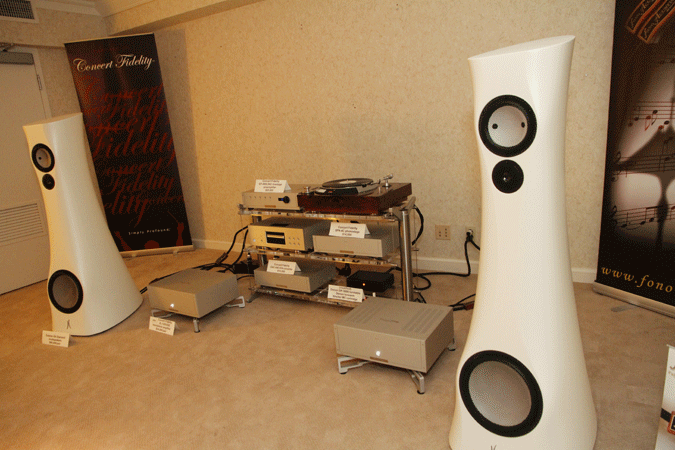
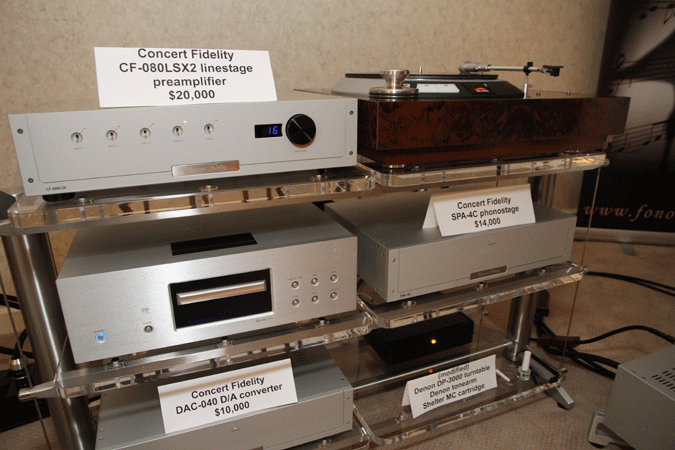
The room featuring the Estelon XA Diamond loudspeakers ($43,900/pair) was easily one of the best sounding rooms I heard this year. The rest of the system consisted of the new Concert Fidelity ZL-120V2SE mono amps ($34,000/pair), DAC-040 ($10,000), CF-080LSX2 preamp ($20,000), and SPA-4C phonostage ($14,000). Source components were the Denon DP3000 turntable and tonearm and Shelter cartridge and Esoteric CD player. Fono Acustica provided the cabling. Because of their rather understated looks, I have always thought of Concert Fidelity equipment as being way overpriced and frankly, inexpensive looking. But there’s no denying how good this system sounded.
Over at the Venetian things were jumping, though not quite with the same gusto as I remember from my last CES I attended in 2010. Still, this year I did notice a few industry trends. The most prominent had to be that many rooms preferred to do demos with hi-rez audio files or utilizing an iTunes library. To be honest, I felt awkward asking to hear a CD in most rooms. It seemed everybody had an iPad. Another trend was the number of rooms that played hi-rez files that had been ripped from vinyl records. The room that impressed me most with this technology was the Light Harmonic room. They said they had used the analog rig of Stereophile’s Michael Fremer to rip vinyl albums to their own prototype music server. For their demo they played those files via their awesome Davinci 384k USB DAC ($20,000). The only way I could describe the sound of the ripped LPs is glorious. Ironically, all the subtle nicks and pops that you get with vinyl, you still get when you rip them, but some how it seemed to add a greater sense of naturalness to the music. The rest of the demo system consisted of an Aurender A10 music server, Pass Labs electronics and Wilson Sophia loudspeakers.
Genesis Advanced Technologies is a company that I’ve gotten to be very familiar with in the last year or so thanks to Arnold at Tweak Studio. A quick visit to their room reminded me why. Gary Koh, President of Genesis, had an excellent sounding demo featuring his Genesis 7.2f loudspeakers ($9,000/pair) being driven by the Genesis Anniversary Monoblock amps ($13,000/pair). He also showed a prototype of his phonostage connected to a Funk Firm Saffire turntable. He used MSB Technology Platinum Signature DAC IV and Signature Data CD IV to play CDs. The cabling was none other than his own design called Absolute Fidelity, which I recently reviewed the power cord. A great sounding room.
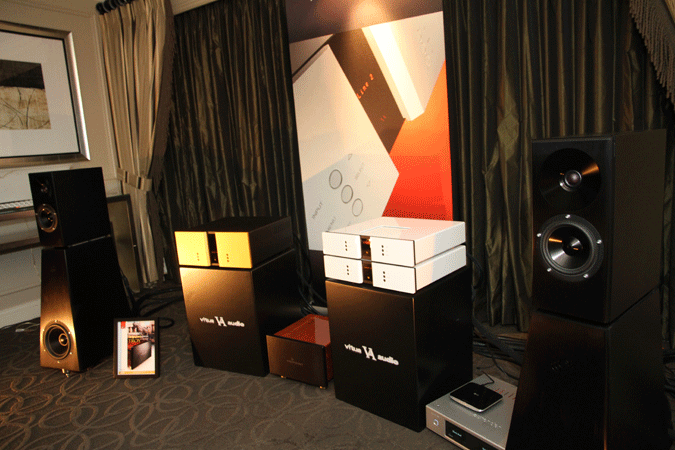
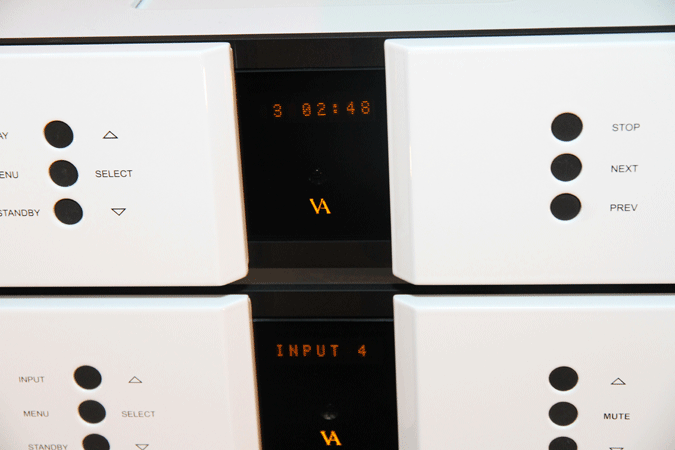
Vitus Audio is always a reliably great sounding room and this year was no different. Though unlikely most other years that I’ve visited this room, this year none of their super-megabuck gear was to be found. Instead, Hans-Ole Vitus, the man behind the gear was demonstrating his lower priced “Reference Series” products. The system consisted of the RCD-100 CD player ($13,000), RL-101 linestage ($11,000), and RS-100 stereo amp ($13,000). If you know the Vitus product line, you’ll know that this is about as low priced as Vitus gear gets. But unlike the Concert Fidelity gear that I mentioned earlier, the Vitus gear still has the look of its much more expensive siblings but is also loaded with a ton of options. Vitus used a pair of YG Acoustics Kipod II Signature loudspeakers ($49,000/pair) and an Aurender music server.
Also of note in the Vitus room were the products from Tripoint Audio. Tripoint President Miguel Alvarez, demonstrated the effects of his Orion Master A/C Conditioner ($20,000) and Troy component grounding system ($12,000). These products did make a positive impact on the sound, even at a relatively low volume level. But at $32,000 for the pair, I’m not sure of the market for products that some audiophiles may still regard as accessories. But these are nice products and Miguel is very passionate about their capabilities, so if you can afford them the Tripoint products may be well worth seeking out.
Not being used in his room but on display in a couple of others was the awesome Vitus Audio RI-100 integrated amp ($13,000). This 300-watt beast comes with a preamp output for use in a bi-amp configuration and soon phono and DAC modules will be available for ultimate flexibility. Another room that used Vitus amps was the Piega room which used my personal favorites, the SM-010 25-watt class-A monoblocks to drive the Piega Coax 70.2 loudspeakers ($13,000/pair). This was a terrific combination.
CES Sponsor
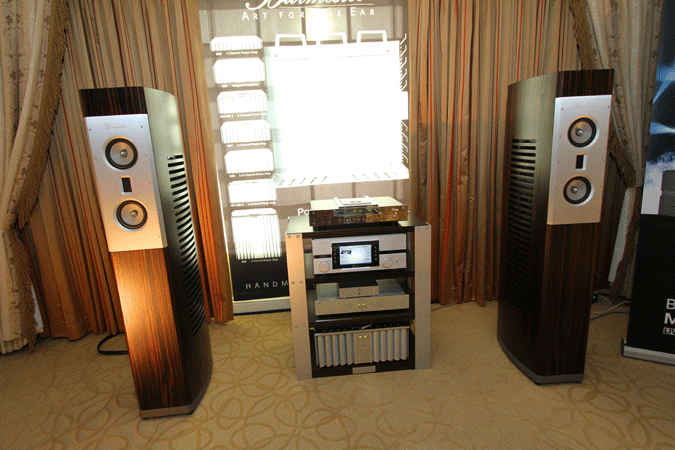
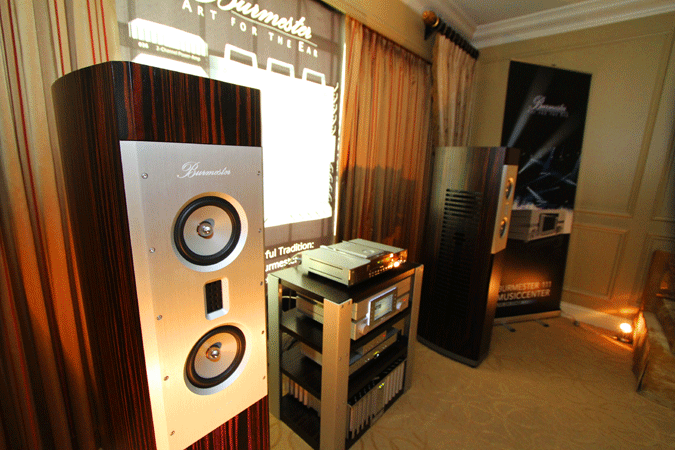
I’ve become a big fan of this company since their products have been made available in the Chicago area via the Tweak Studio. Their show demo system was also pretty impressive. It included the 089 CD player ($28,995), 911 MK 3 amplifier ($29,995), and B80 loudspeakers ($54,995/pair). But the most exciting product they showed was their new 111 Musiccenter ($50,000). The Musiccenter features a lovely front panel display from which you can easily control its six digital inputs, three analog inputs, and music streaming capabilities. The sound was naturally expansive and musical.
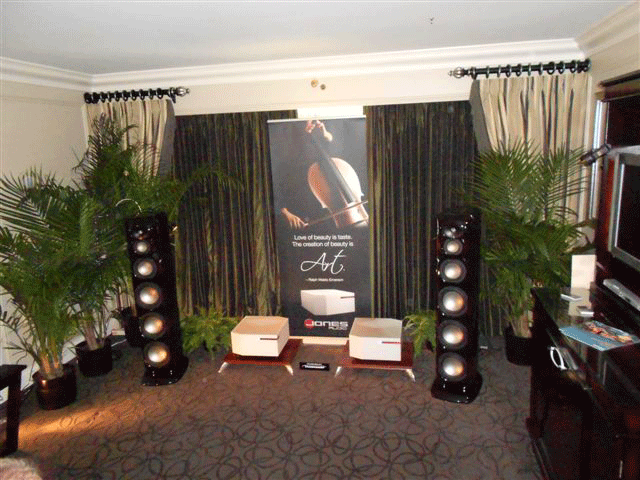
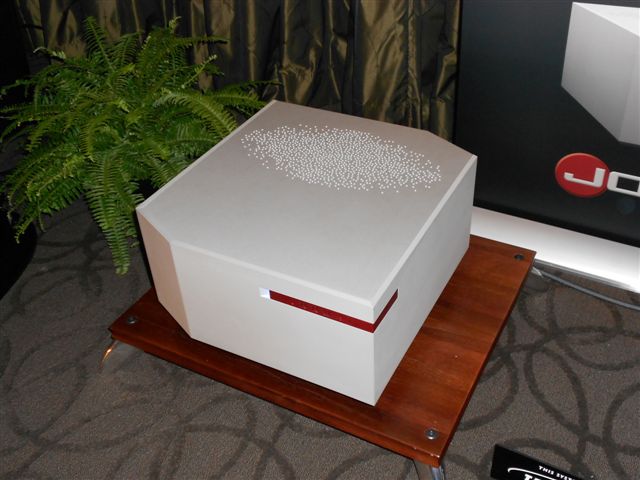
A very pleasant surprise for me was the Jones Audio room. Upon seeing the stunning beauty of these components up close, I immediately assumed that this was yet another European company that put a premium on bullet-proof construction, modern art aesthetics, and intense musicality. But it turns out that the company actually hails from the Great Northwest in Black Diamond, Washington. They partnered their PA-M300 mono amps and Pre S-1 preamp with the wonderful Revel Salon 2 loudspeakers. The system was fronted by the Oppo Digital BDP-95 Universal Disc player ($999.00).
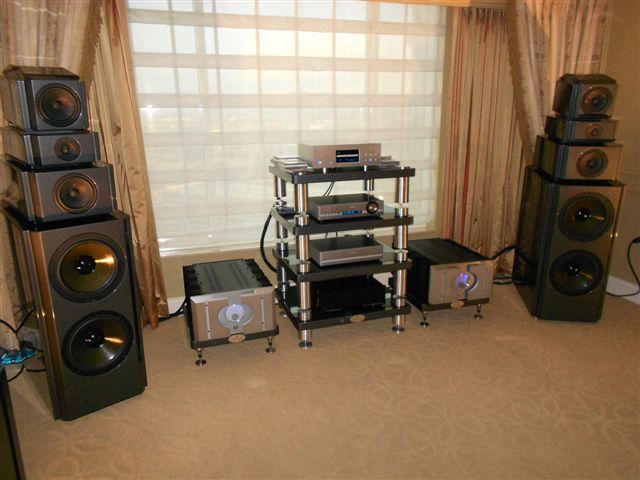
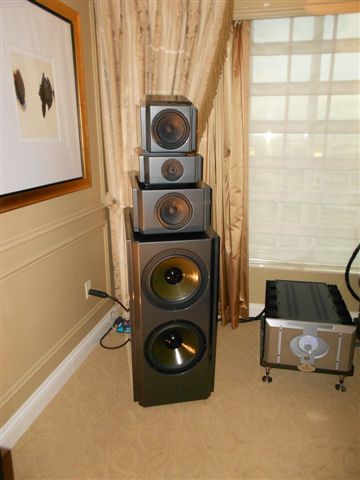
NTT Audio: This is always an interesting company to visit at CES. Yes, they have brazenly knocked off the aesthetics of the Wilson Audio speakers, but damn, do they sound good. This year the always enthusiastic Michael Lee was showing off the new NTT103 MK 2 ($155,000/pair). Being driven by Pass Labs amplification, the music sounded like the system looked… big and powerful. Ironically, these speakers have an efficiency rating of 95dB! So with a nice pair of tube amps these monsters can be gentle giants.
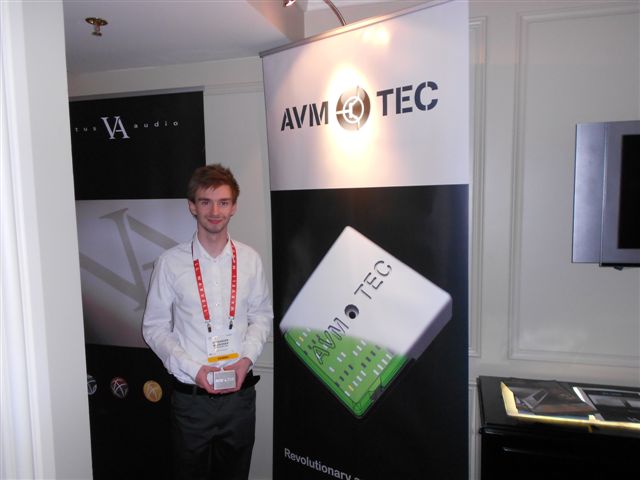
Alexander Vitus Mogensen. If you don’t recognize the first and last names, you most certainly will recognize the middle name. Yes, Alexander Vitus Mogensen is the son of legendary audio designer, Hans-Ole Vitus. After five years of working for his father, Alexander has decided to put his experience and considerable abilities as a musician into building his own company called AVM-TEC. This new company manufactures OEM and DIY audio modules for the electrical and mechanical manufacturing industry. 2012 will see him put forth his first line of audio products including linestage and phonostage kits and an active crossover kit. If any of his father’s audio building DNA is in him, AVM-TEC could be a very exciting company to watch in the years to come.
Onda Systems
I visited with Greg Kozokowsky and Ken Sim of Canadian cable manufacturer Onda Systems. Ordinarily a cable company would not draw my attention for very long at a show, but these guys were just really cool to hang with for a while. They are very passionate about their products, as you might expect, but they also seem to be very astute businessmen as well, by offering a 15-day money back guarantee and a unique trade-up program to enhance long-term customer satisfaction. Onda offers a full line of cables from their entry level Kyra 1&2 cables to their top-of-the-line Riptide cables. The look of all of these cables was very elegant and the sound very detailed. They connected a system featuring an Acustic Arts CD 1 CD player, Aesthetix Janus preamp and Atlas amps, and a pair of Vandersteen 5A carbon loudspeakers.
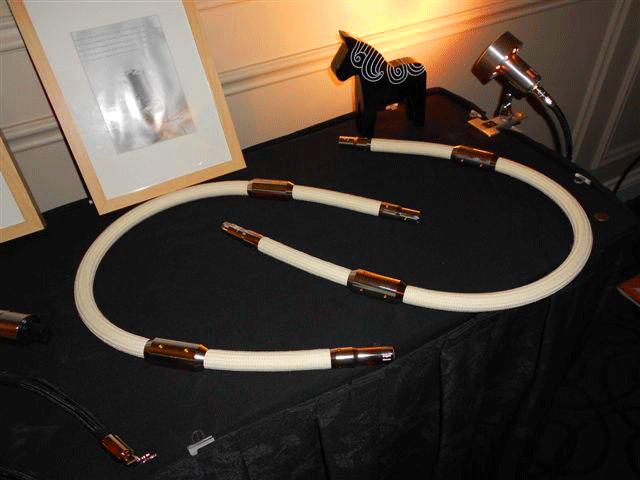
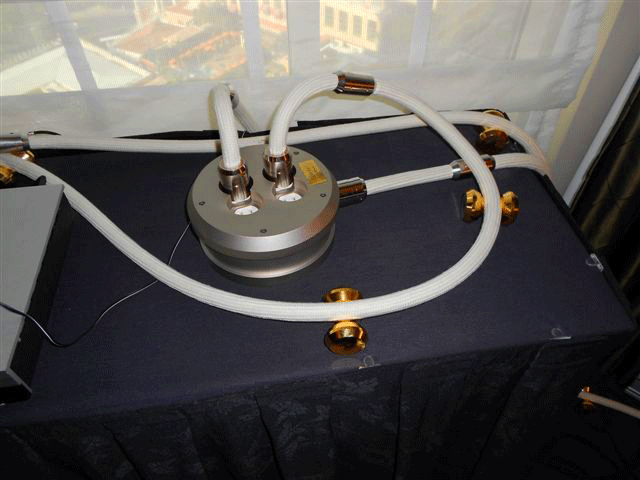
This company had easily one of the most interesting and maybe controversial products at this year’s CES. Telos manufactures a complete line of accessories from RCA and XLR connection caps to their TD-04R Power Distributor ($3,200). But what really blew me away was a product that did nothing to enhance the sound of your music, instead it is designed to enhance you and your ability to enjoy listening. That’s right, it is designed to relax you so that you can enjoy the music more. I’ll have to admit that when they told me this, my bullshit radar went off the charts. But I did enjoy listening to music in that room. I just can’t say whether this device had anything to do with it. Anyway, who am I to doubt them given the plethora of Tibetan micro-bowls, room correction devices, and all the other stuff out there that promises similar results. Seek it out and judge for yourself. Telos does also make some pretty impressive looking cables though, and the system in their room, which consisted of computer audio files played through a Perreaux Audiant 80i integrated amp and Usher Mini 2 loudspeakers connected by Telos Platinum Reference cables sounded nicely detailed and musical.
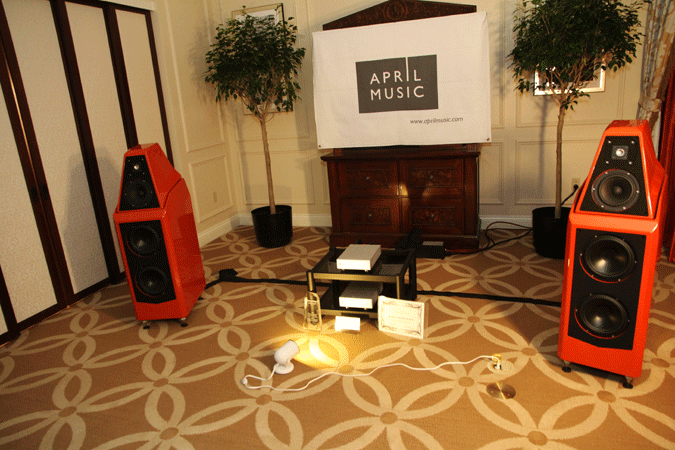
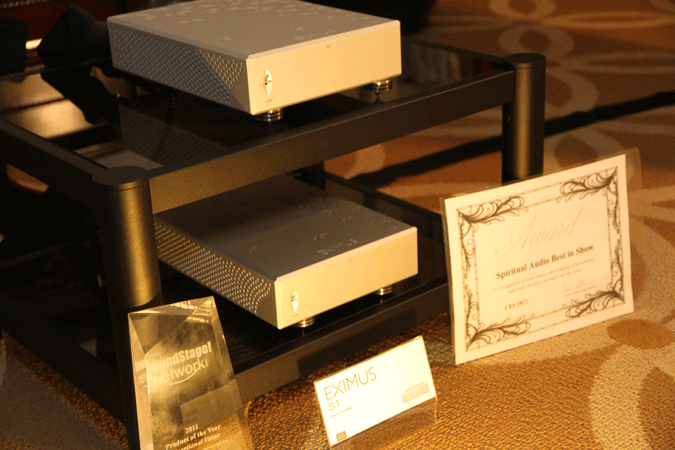
It had been a while since I had heard anything from April Music, the Seoul South Korea-based company behind such great and affordable product lines as Stello, Aura Note, and Eximus. It was in this room that I had one of my favorite listening experiences ever at a hi-fi show. They were playing hi-rez music files through the Eximus DP1 192/24 DAC-Preamp ($2,995) and a pair of S1 stereo amps ($2,495/ea) that were bridged and used as mono amps. The amps were driving a pair of Wilson Audio Sasha loudspeakers and the cabling was from Verastarr. What made this such a great experience was the rare music that April Music’s U.S. Sales Manager, Jay Paul Apodaca played, including a never before heard acoustic performance by Michael Jackson.
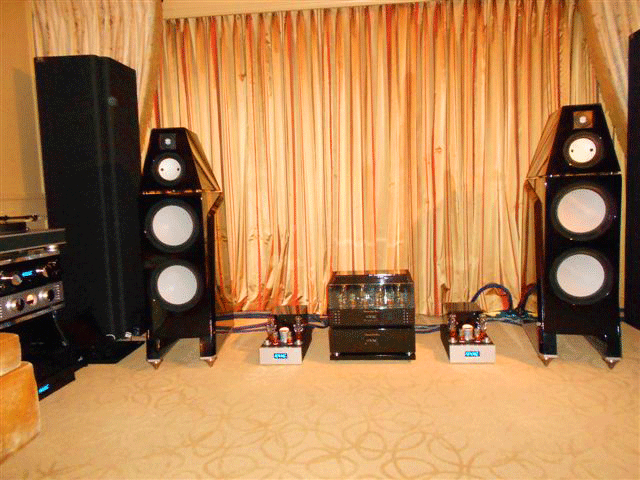
One of my favorite all time speakers was the Talon Audio Peregrine X. This was a speaker designed by Tierry Budge and was the predecessor for the Escalante Design Fremont, which is my current reference. But for the last few years, the Talon brand has been owned by Rives Audio’s Richard Rives Bird. Under Rives, Talon has continued to improve upon designs like the Firebird and Hawk. Now comes the stunningly beautiful Phoenix Reference, which can be bought with an active ($75,000/pair) or passive ($95,000/pair) crossover. The active version incorporates Rives Audio’s unique Parametric Adaptive Room Compensation (PARC) technology and a 500-watt amplifier. The demo system had the speakers being by VAC electronics and a Dr. Feickert Firebird turntable ($12,995) with Graham Phantom II Supreme 9” tonearm ($5,500) and Benz Ruby Z cartridge ($4,000). Kubala Sosna Emotion and Elation cables connected the system. The sound from this room was fabulous; rich detailed and expansive. One of the finest sounding rooms I heard this year.
Classe Audio
Once again, Classe Audio sought the relative peace and tranquility of a suite at the Mirage. Here is where I met Regional Sales Manager, Marc Scholl who was kind enough to give me a demonstration of the many capabilities of Classe’s new CP-800 preamp. As you may already have read on this site, I reviewed the stellar CA-M600 mono amps back in the fall of last year. I just received the CP-800 a few weeks before the CES, so a full review of this system will be forthcoming. I can say that Classe continues to amaze me by building world class components with thoughtful technological advances, while keeping their prices shockingly sane. At around $5,000 the CP-800 fits that mold perfectly.
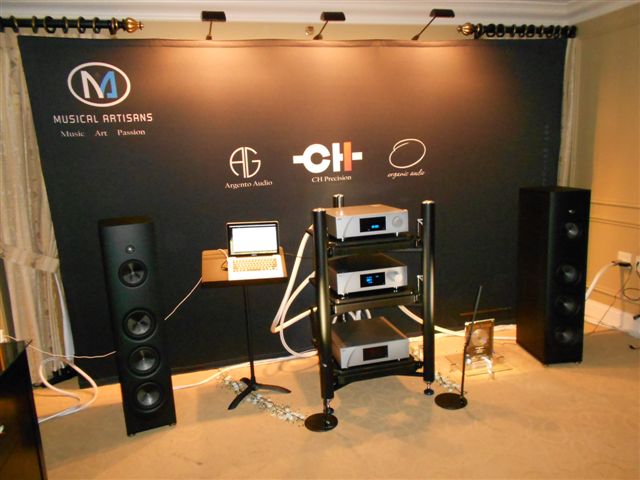
After attending this year’s show and visiting their room, Musical Artisans, a Chicago area dealership is high on my list of “must see dealers.” Ricardo Reyes, the proprietor of Musical Artisans, has an unflinching dedication to the high-end that audio purists come to appreciate. His room at CES was a shining example of this commitment. He brilliantly put together a system comprising the CH Precision D1 CD/SACD player and transport ($40,000), C1 DAC, preamplifier and network player ($33,000), Luxman M800 stereo power amplifier ($16,000), and Magico Q3 loudspeakers. The system was connected via Argento Audio cables. The CH Precision components are absolutely stunning to look at and their modular design gives you enormous flexibility and upgradability. And kudos to them for having one of the slickest and easiest to read front panel displays I’ve ever seen. But most importantly, the sound of this system was spectacular. I’ll be making a special trip to hear it again. Musical Artisans is the distributor of Argento Audio, CH Precision, and Organic Audio, and is also the dealer for these products in the Chicago area.
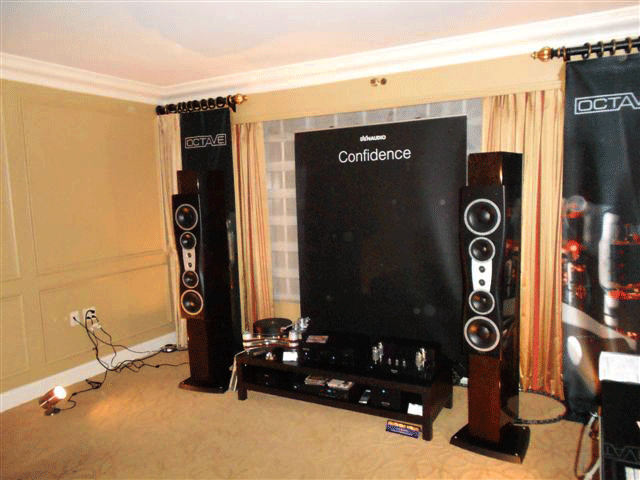
Like Classe, Dynaudio is another company that consistently produces world class products whose quality of construction, design and sonics makes its pricing seem reasonable. I’ve spent a lot of time with the company’s Sapphire loudspeakers in my reference system and they still rate them as one of the best bargains in high-end speakers. Now comes the new and improved Dynaudio C4 Signature Edition ($22,000/pair). It has a revised crossover, and a new Esotar2 tweeter. The system in this room was fronted by a T+A SACD 1260-R CD player and Clearaudio Innovation turntable. The Octave Audio HP 500SE preamp and RE-290 tube amplification drove the C4s. There’s a new signature version of the C1 stand-mounted speakers as well ($8,500/pair). Both speakers are now available with gorgeous upgraded high-gloss finishes. The sound in this room was very nice but there were too many people milling about for me to get the proper attitude. I’m gonna have to chat up fellow Chicagoan, Mike Manousselis, Dynaudio’s North American Director of Sales and Marketing, about a pair of the C4s for a review. Stay tuned.
The final room I’m reporting on this year is also the one I’m giving the title, “Best Sound at the Show” to. Magico is one of those companies that I’d have to admit to having a love/hate relationship with. The hate comes from the fact that they are just so darned expensive. I was immediately turned off a couple of years ago by the bookshelf-sized Magico Mini II. Despite its build quality and sonics, I could not get past its silly $30,000/pair price tag. I’ve had comparable reactions to subsequent Magico offerings since then. But this year I’m calling for a personal truce with myself because of what I witnessed in their room at the Ventian.
First, the new Magico S5 at $28,600/pair, may be about as close to a price-matches-the-product offering that I’ve seen from this company. I say “may be” because I didn’t actually get to hear them. But for the first time, I saw a pair of Magico speakers, thought to myself how much they should cost and was almost correct. If they sound as great as they look, they may even border on, dare I say… bargain. The show demo pair featured a beautiful cherry-red finish that had to be seen to be believed. I asked Director of Sales, Irv Gross to put me on the (long, I’m sure) list of folks who’ll want to review them. So stay tuned, but don’t hold your breath.
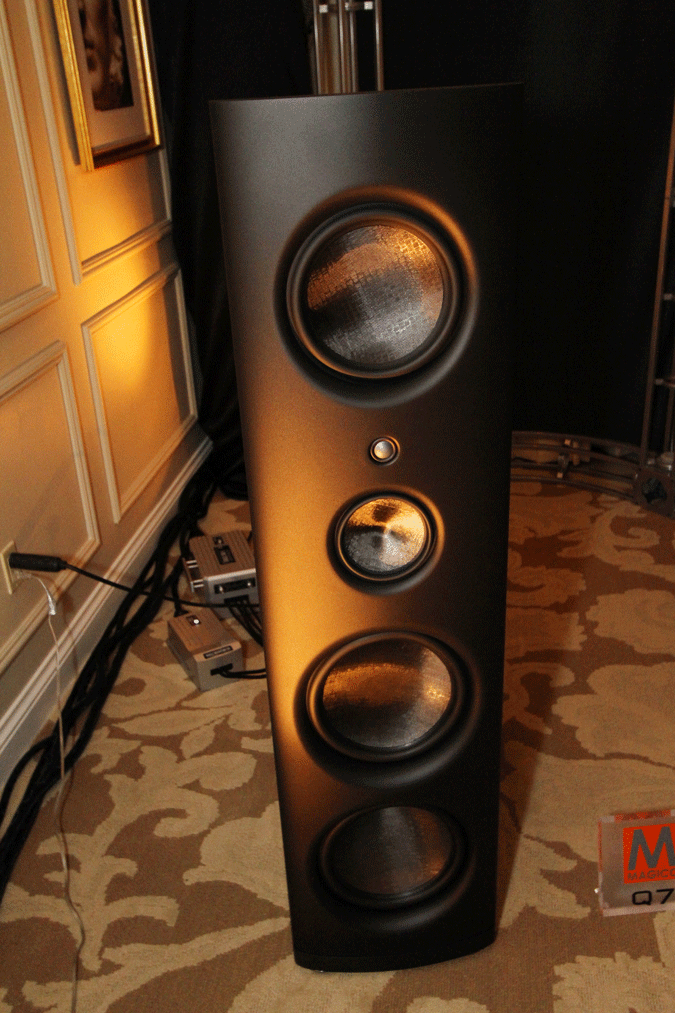
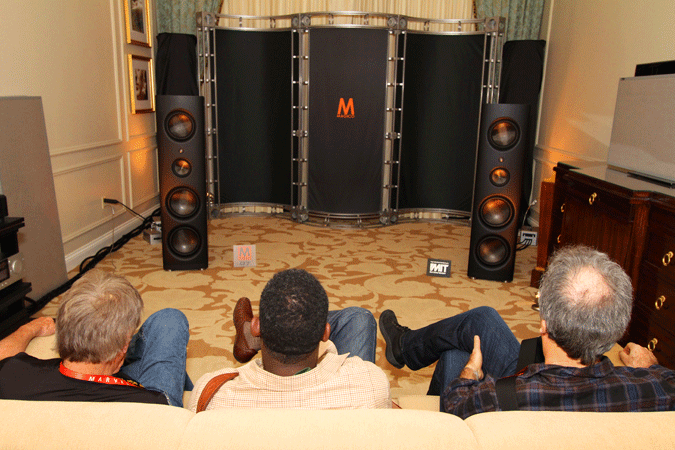

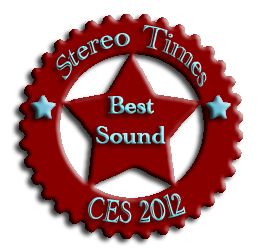 But finally, my best sound accolade has to go (ironically) to the most expensive Magico speaker of all; the massive, 750 lb., $165,000/pair Q7. Yes, this is a crazy expensive speaker, but man(!) did they sound good! I mean jaw dropping, bank robbing, rethinking the importance of eating and homeownership good. This speaker is a four-way, five driver, 4 Ohm design, that has the audacity to also be 94dB efficient. It uses a 1” tweeter, 6” midrange, 10” midbass driver and two 12” woofers, all using Magico’s Nano-Tec cone technology. The sound? GRAND! OPEN! DETAILED! DEEP! Just about what you should get for $165K.
But finally, my best sound accolade has to go (ironically) to the most expensive Magico speaker of all; the massive, 750 lb., $165,000/pair Q7. Yes, this is a crazy expensive speaker, but man(!) did they sound good! I mean jaw dropping, bank robbing, rethinking the importance of eating and homeownership good. This speaker is a four-way, five driver, 4 Ohm design, that has the audacity to also be 94dB efficient. It uses a 1” tweeter, 6” midrange, 10” midbass driver and two 12” woofers, all using Magico’s Nano-Tec cone technology. The sound? GRAND! OPEN! DETAILED! DEEP! Just about what you should get for $165K.
Both times I visited this room I could not get close enough to the demo system to tell you what was in it, though I heard that the electronics were from Solution Audio (possibly prototypes) and that Spectral and a reel to reel were involved as well. Whatever the system was, the result was one of the most spectacular sounding things I’ve ever heard at a show, and definitely this one.
See you next year?

Stereo Times Masthead
Publisher/Founder
Clement Perry
Editor
Dave Thomas
Senior Editors
Frank Alles, Mike Girardi, Russell Lichter, Terry London, Moreno Mitchell, Paul Szabady, Bill Wells, Mike Wright, and Stephen Yan,
Current Contributors
David Abramson, Tim Barrall, Dave Allison, Ron Cook, Lewis Dardick, John Hoffman, Dan Secula, Don Shaulis, Greg Simmons, Eric Teh, Greg Voth, Richard Willie, Ed Van Winkle, Rob Dockery, Richard Doran, and Daveed Turek
Site Management Clement Perry
Ad Designer: Martin Perry







Be the first to comment on: The Mark Levinson (The Man) Experience